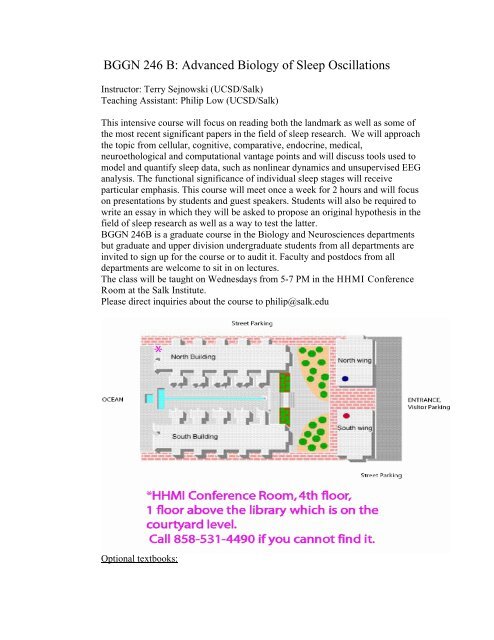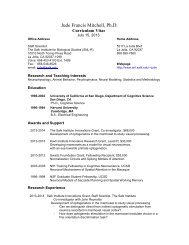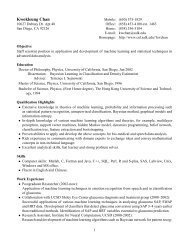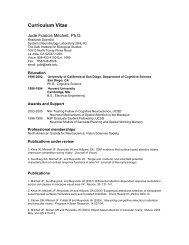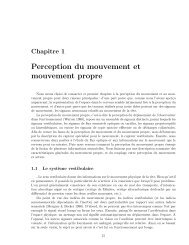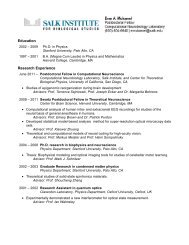BGGN 246 B: Advanced Biology of Sleep Oscillations
BGGN 246 B: Advanced Biology of Sleep Oscillations
BGGN 246 B: Advanced Biology of Sleep Oscillations
Create successful ePaper yourself
Turn your PDF publications into a flip-book with our unique Google optimized e-Paper software.
<strong>BGGN</strong> <strong>246</strong> B: <strong>Advanced</strong> <strong>Biology</strong> <strong>of</strong> <strong>Sleep</strong> <strong>Oscillations</strong>Instructor: Terry Sejnowski (UCSD/Salk)Teaching Assistant: Philip Low (UCSD/Salk)This intensive course will focus on reading both the landmark as well as some <strong>of</strong>the most recent significant papers in the field <strong>of</strong> sleep research. We will approachthe topic from cellular, cognitive, comparative, endocrine, medical,neuroethological and computational vantage points and will discuss tools used tomodel and quantify sleep data, such as nonlinear dynamics and unsupervised EEGanalysis. The functional significance <strong>of</strong> individual sleep stages will receiveparticular emphasis. This course will meet once a week for 2 hours and will focuson presentations by students and guest speakers. Students will also be required towrite an essay in which they will be asked to propose an original hypothesis in thefield <strong>of</strong> sleep research as well as a way to test the latter.<strong>BGGN</strong> <strong>246</strong>B is a graduate course in the <strong>Biology</strong> and Neurosciences departmentsbut graduate and upper division undergraduate students from all departments areinvited to sign up for the course or to audit it. Faculty and postdocs from alldepartments are welcome to sit in on lectures.The class will be taught on Wednesdays from 5-7 PM in the HHMI ConferenceRoom at the Salk Institute.Please direct inquiries about the course to philip@salk.eduOptional textbooks:
<strong>Sleep</strong> and Wakefulness.Kleitman, N. The University <strong>of</strong> Chicago Press, Chicago, 1963The Neural Control <strong>of</strong> <strong>Sleep</strong> and WakingSiegel, J. Springer, 2002Brain Control <strong>of</strong> Wakefulness and <strong>Sleep</strong>Steriade, M and McCarley, R. Springer, 2005Thalamocortical AssembliesDestexhe, A and Sejnowski, T. Oxford University Press, USA, 2001All I Want Is a Good Night's <strong>Sleep</strong>Ancoli-Israel, S. C.V. Mosby, 1996Principles and Practice <strong>of</strong> <strong>Sleep</strong> Medicine, 4th editionKryger, M (ed.), Roth, T (ed.), Dement, W (ed.) Saunders/Elsevier, 2005DreamingHobson, JA. Oxford University Press, USA, 2004Secrets <strong>of</strong> <strong>Sleep</strong>Borbely, A. Basic Books, 1988.Pharmacology <strong>of</strong> <strong>Sleep</strong>Kales, A (ed.), Springer, 1995.A Universe <strong>of</strong> ConsciousnessEdelman, GM and Tononi, G. Basic Books, 2001<strong>Sleep</strong> Deprivation: Clinical Issues, Pharmacology, and <strong>Sleep</strong> LossEffects.Kushida C, editor. New York: Marcel Dekker; 2005.Topics:I. April 5 th . Circadian Rhythms.5:30-6:30 PM. Satchin Panda (Salk)6:30-7:30 PM. David Welsh (TSRI)Synchronization and maintenance <strong>of</strong> timekeeping in suprachiasmaticcircadian clock cells by neuropeptidergic signaling.Maywood ES et al. Curr Biol. 2006 Mar 21;16(6):599-605.A clockwork web: circadian timing in brain and periphery, in healthand disease.Hastings MH, Reddy AB, Maywood ES. Nat Rev Neurosci. 2003Aug;4(8):649-61.Strange vision: ganglion cells as circadian photoreceptors.Berson DM. Trends Neurosci. 2003 Jun;26(6):314-20.Bioluminescence Imaging <strong>of</strong> Individual Fibroblasts RevealsPersistent, Independently Phased Circadian Rhythms <strong>of</strong> Clock GeneExpressionWelsh D et al. Curr Biol. 2004 Dec 29;14(24):2289-95.
Physiology. Biological clocks coordinately keep life on time.Gillette MU, Sejnowski TJ. Science. 2005 Aug 19;309(5738):1196-8.Illumination <strong>of</strong> the melanopsin signaling pathway.Panda S, Nayak SK, Campo B, Walker JR, Hogenesch JB, Jegla T.Science 2005 Jan 28;307(5709):600-4.II.April 12 th . Hypocretins and HPA axis regulation during sleep.5:00-6:00 PM. Luis de Lecea (Stanford)6:00-7:00 PM. Student presentations: Chris Robinson (UCSD)& Justin Brady (UCSD).The hypocretins: setting the arousal threshold.Sutcliffe, J.G., de Lecea, L. Nat Rev Neurosci. 2002 May;3(5):339-49.Hypocretin (orexin): role in normal behavior and neuropathology.Siegel JM. Annu Rev Psychol. 2004;55:125-48.Lesions <strong>of</strong> the suprachiasmatic nucleus eliminate the daily rhythm <strong>of</strong>hypocretin-1 release.Zhang S et al. <strong>Sleep</strong>. 2004 Jun 15;27(4):619-27.The role <strong>of</strong> hypocretins (orexins) in sleep regulation and narcolepsy.Taheri S, Zeitzer JM, Mignot E. Annu Rev Neurosci. 2002;25:283-313.III.April 19 th . EEG I: <strong>Sleep</strong>.5:00 -7:00 PM. Philip Low (Salk)Limitations <strong>of</strong> Rechtschaffen and Kales.Himanen SL, Hasan J. <strong>Sleep</strong> Med Rev. 2000 Apr;4(2):149-167.Automated sleep staging in rat with a standard spreadsheet.Costa-Miserachs D, Portell-Cortes I, Torras-Garcia M, Morgado-Bernal I.J Neurosci Methods. 2003 Nov 30;130(1):93-101.Global forebrain dynamics predict rat behavioral states and theirtransitions.Gervasoni D, Lin SC, Ribeiro S, Soares ES, Pantoja J, Nicolelis MA.J Neurosci. 2004 Dec 8;24(49):11137-47.
Supplementary Reading (optional):Hans Berger: from psychic energy to the EEG.Millett D. Perspect Biol Med. 2001 Fall;44(4):522-42. OptionalRegularly occurring periods <strong>of</strong> eye motility, and concomitantphenomena, during sleep.Aserinsky & Kleitman. Science. 1953 Sep 4;118(3062):273-4.IV.April 26 th . Thalamocortical <strong>Oscillations</strong> & EEG II:Drowsiness.5:00 - 6:00 PM. Maxim Bazhenov (Salk)6:00 - 7:00 PM Scott Makeig (UCSD)Thalamocortical oscillations in the sleeping and aroused brain.Steriade M, McCormick DA, Sejnowski TJ.Science. 1993 Oct 29;262(5134):679-85.Origin <strong>of</strong> slow cortical oscillations in deafferented cortical slabs.Tim<strong>of</strong>eev I, Grenier F, Bazhenov M, Sejnowski TJ, Steriade M.Cereb Cortex. 2000 Dec;10(12):1185-99.Model <strong>of</strong> thalamocortical slow-wave sleep oscillations and transitionsto activated States.Bazhenov M, Tim<strong>of</strong>eev I, Steriade M, Sejnowski TJ.J Neurosci. 2002 Oct 1;22(19):8691-704.Tonic, phasic, and transient EEG correlates <strong>of</strong> auditory awareness indrowsiness.Makeig S, Jung TP. Brain Res Cogn Brain Res. 1996 Jul;4(1):15-25.V. May 3rd. Clinical Disorders and sleep.5:00 - 6:00 PM. Sonia Ancoli-Israel (UCSD - VA)6:00 - 7:00 PM. Student Presentations: Sarah Israel (UCSD) &Issa Rammal (UCSD)Insomnia in Primary Care:Overcoming Diagnostic and Treatment BarriersPostgraduate Medicine. McGraw-Hill, 2004Insomnia.Sateia MJ, Nowell PD. Lancet. 2004 Nov 27-Dec 3;364(9449):1959-73.
<strong>Sleep</strong>-disordered breathing and cardiovascular disease.Phillips B. <strong>Sleep</strong> Med Rev. 2005 Apr;9(2):131-40.Treatment <strong>of</strong> chronic insomnia. An American Academy <strong>of</strong> <strong>Sleep</strong>Medicine review.Morin,C.M. et al. Nonpharmacologic <strong>Sleep</strong> 22:1134-56, 1999.NIH State <strong>of</strong> the Science Conference Statement on Insomnia.Manifestations and Management <strong>of</strong> Chronic Insomnia in Adults June13-15, 2005.<strong>Sleep</strong> 28:1049-1058, 2005.<strong>Sleep</strong> deprivation and clinical performance.Weinger MB, Ancoli-Israel S. JAMA. 2002 Feb 27;287(8):955-7.Supplementary Reading (optional):Epidemiology <strong>of</strong> insomnia: what we know and what we still need tolearn.Ohayon, M.M. <strong>Sleep</strong> Medicine Reviews 6:97-111, 2002.What are the contributing factors for insomnia in the generalpopulation?Ohayon,M.M. and Roth,T. J Psychosomatic. Res 51:745-755, 2001.Assessment and diagnosis <strong>of</strong> insomnia in non-pharmacologicalintervention studies.Martin JL, Ancoli-Israel S. <strong>Sleep</strong> Med Rev. 2002 Oct;6(5):379-406.Derivation <strong>of</strong> research diagnostic criteria for insomnia: report <strong>of</strong> anAmerican Academy <strong>of</strong> <strong>Sleep</strong> Medicine Work Group.Edinger JD et al. <strong>Sleep</strong>. 2004 Dec 15;27(8):1567-96.<strong>Sleep</strong> disorders in Alzheimer's disease and other dementias.Bliwise DL. Clin Cornerstone. 2004;6 Suppl 1A:S16-28.VI.May 10 th . <strong>Sleep</strong> deprivation I. A Clinical Perspective.5:00 - 6:00 PM. Daniel Kripke (UCSD)6:00 - 7:00 PM. Student Presentations: Brad Aimone (Salk) &Sabrina Xiang (UCSD)
Do we sleep too much?Kripke DF. <strong>Sleep</strong>. 2004 Feb 1;27(1):13-4..No association <strong>of</strong> sleep with total daily physical activity in normalsleepers.Youngstedt SD, Perlis ML, O'Brien PM et al. Physiology &Behavior 2003;78:395-401.Long sleep and mortality: rationale for sleep restriction.Youngstedt SD, Kripke DF. <strong>Sleep</strong> Medicine Reviews 2004;8:159-74.Supplementary Reading (optional):Functional imaging <strong>of</strong> the sleeping brain: review <strong>of</strong> findings andimplications for the study <strong>of</strong> insomnia.Drummond SP, Smith MT, Orff HJ, Chengazi V, Perlis ML.<strong>Sleep</strong> Med Rev. 2004 Jun;8(3):227-42.Altered brain response to verbal learning following sleep deprivation.Drummond SP, Brown GG, Gillin JC, Stricker JL, Wong EC, Buxton RB.Nature. 2000 Feb 10;403(6770):655-7.<strong>Sleep</strong> deprivation as a model experimental antidepressant treatment:findings from functional brain imaging.Gillin JC, Buchsbaum M, Wu J, Clark C, Bunney W Jr.Depress Anxiety. 2001;14(1):37-49.Different effects <strong>of</strong> phenelzine treatment on EEG topography inwaking and sleep in depressed patients.Landolt HP, Gillin JC. Neuropsychopharmacology. 2002 Sep;27(3):462-9.VII. May 17th. <strong>Sleep</strong> deprivation II.5:00 - 6:00 PM. Ralph Greenspan (NSI)6:00 - 7:00 PM. Student presentations: Sarah Israel (UCSD) &Issa Rammal (UCSD)<strong>Sleep</strong> and Wakefulness.Kleitman, N. The University <strong>of</strong> Chicago Press, Chicago, 1963, pp. 215-229.<strong>Sleep</strong> deprivation in the rat: X. Integration and discussion <strong>of</strong> thefindings. 1989. (reprint)Rechtschaffen A et al. <strong>Sleep</strong>. 2002 Feb 1;25(1):68-87.
Stress response genes protect against lethal effects <strong>of</strong> sleep deprivationin Drosophila.Shaw PJ, Tononi G, Greenspan RJ, Robinson DF.Nature. 2002 May 16;417(6886):287-91.Supplementary Reading (optional) :Unihemispheric enhancement <strong>of</strong> delta power in human frontal sleepEEG by prolonged wakefulness.Achermann P, Finelli LA, Borbely AA. Brain Res. 2001 Sep21;913(2):220-3.<strong>Sleep</strong> deprivation reduces proliferation <strong>of</strong> cells in the dentate gyrus <strong>of</strong>the hippocampus in rats.Guzman-Marin et al. J Physiol. 2003 Jun 1;549(Pt 2):563-71.<strong>Sleep</strong> deprivation impairs long-term potentiation in rat hippocampalslices.Campbell IG, Guinan MJ, Horowitz JM.J Neurophysiol. 2002 Aug;88(2):1073-6.<strong>Sleep</strong> deprivation causes behavioral, synaptic, and membraneexcitability alterations in hippocampal neurons.McDermott CM, LaHoste GJ, Chen C, Musto A, Bazan NG, Magee JC.J Neurosci. 2003 Oct 22;23(29):9687-95.<strong>Sleep</strong>: suppression <strong>of</strong> rapid eye movement phase in the cat afterelectroconvulsive shock.Cohen HB, Dement WC. Science. 1966 Oct 21;154(747):396-8.<strong>Sleep</strong> deprivation in the rat: an update <strong>of</strong> the 1989 paper.Rechtschaffen A, Bergmann BM. <strong>Sleep</strong>. 2002 Feb 1;25(1):18-24.Uncoupling <strong>of</strong> brain activity from movement defines arousal States inDrosophila.van Swinderen B, Nitz DA, Greenspan RJ.CurrBiol. 2004 Jan 20;14(2):81-7.VIII. May 24 th . Off-line Processing I. Psychophysics.5:00 - 6:00 PM. Sara Mednick (Salk)6:00 - 7:00 PM. Student presentations: Sabrina Xiang (UCSD)& Justin Brady (UCSD)
The restorative effect <strong>of</strong> naps on perceptual deterioration.Mednick SC et al. Nat Neurosci. 2002 Jul;5(7):677-81.<strong>Sleep</strong>-dependent learning: a nap is as good as a night.Mednick S, Nakayama K, Stickgold R. Nat Neurosci. 2003 Jul;6(7):697-8.Dependence on REM sleep <strong>of</strong> overnight improvement <strong>of</strong> a perceptualskill.Karni A et al. Science. 1994 Jul 29;265(5172):679-82.Consolidation during sleep <strong>of</strong> perceptual learning <strong>of</strong> spoken language.Fenn KM, Nusbaum HC, Margoliash D.Nature. 2003 Oct 9;425(6958):614-6.<strong>Sleep</strong>-dependent memory consolidation.Stickgold R. Nature 2005 Oct 27;437(7063):1272-78.<strong>Sleep</strong>, learning, and dreams: <strong>of</strong>f-line memory reprocessing.Stickgold R, Hobson JA, Fosse R, Fosse M.Science. 2001 Nov 2;294(5544):1052-7.Replaying the game: hypnagogic images in normals and amnesics.Stickgold et al. Science. 2000 Oct 13;290(5490):350-3.Motor memory consolidation in sleep shapes more effective neuronalrepresentations.Fischer S, Nitschke MF, Melchert UH, Erdmann C, Born J.J Neurosci. 2005 Dec 7;25(49):11248-55.IX.May 31 st . Off-line Processing II. Network Dynamics.5:00-7:00 PM. Student presentations: Brad Aimone (Salk),Chris Robinson (UCSD) & Eviatar Yemini (UCSD).Temporally structured replay <strong>of</strong> awake hippocampal ensembleactivity during rapid eye movement sleep.Louie K, Wilson MA. Neuron. 2001 Jan;29(1):145-56.Reactivation <strong>of</strong> hippocampal ensemble memories during sleep.Wilson MA, McNaughton BL. Science. 1994 Jul 29;265(5172):676-9.Song replay during sleep and computational rules for sensorimotorvocal learning.Dave AS, Margoliash D. Science. 2000 Oct 27;290(5492):812-6.
Replay and time compression <strong>of</strong> recurring spike sequences in thehippocampus.Nadasdy Z, Hirase H, Czurko A, Csicsvari J, Buzsaki G.J Neurosci. 1999 Nov 1;19(21):9497-507.X. June 7 th . Why Do We <strong>Sleep</strong>?5:00 - 7:00 PM. Jerome Siegel (UCLA).Clues to the functions <strong>of</strong> mammalian sleep.Siegel JM. Nature 2005 Oct 27;437(7063):1264-71.The function <strong>of</strong> dream sleep.Crick F, Mitchison G. Nature. 1983 Jul 14-20;304(5922):111-4.The REM sleep-memory consolidation hypothesis.Siegel JM. Science. 2001 Nov 2;294(5544):1058-63.Paradoxical sleep as a programming system.Jouvet M. J <strong>Sleep</strong> Res. 1998;7 Suppl 1:1-5.Why do we sleep?Sejnowski TJ, Destexhe A.Brain Res. 2000 Dec 15;886(1-2):208-223.Slow-wave sleep, acetylcholine, and memory consolidation.Power AE. Proc Natl Acad Sci U S A. 2004 Feb 17;101(7):1795-6.Local sleep and learning.Huber R, Ghilardi MF, Massimini M, Tononi G.Nature. 2004 Jul 1;430(6995):78-81.Supplementary Reading (optional):Freud returns? Like a bad dream.Hobson JA. Sci Am. 2004 May;290(5):89.<strong>Sleep</strong> forms memory for finger skills.Fischer S, Hallschmid M, Elsner AL, Born J.Proc Natl Acad Sci U S A. 2002 Sep 3;99(18):11987-91.
<strong>Sleep</strong> EEG in mice that are deficient in the potassium channel subunitK.v.3.2.Vyazovskiy et al. Brain Res. 2002 Aug 30;947(2):204-11.Symposium: Normal and abnormal REM sleep regulation: Theimportance <strong>of</strong> REM sleep for brain maturation.Mirmiran M, Van Someren E. J <strong>Sleep</strong> Res. 1993 Dec;2(4):188-192.Practice with sleep makes perfect: sleep-dependent motor skilllearning.Walker MP, Brakefield T, Morgan A, Hobson JA, Stickgold R.Neuron. 2002 Jul 3;35(1):205-11.Low acetylcholine during slow-wave sleep is critical for declarativememory consolidation.Gais S, Born J.Proc Natl Acad Sci U S A. 2004 Feb 17;101(7):2140-4.The sleep slow oscillation as a traveling wave.Massimini et al.J Neurosci. 2004 Aug 4;24(31):6862-70.The evolutionary biology <strong>of</strong> self-deception, laughter, dreaming anddepression: some clues from anosognosia.Ramachandran VS.Med Hypotheses. 1996 Nov;47(5):347-62.


